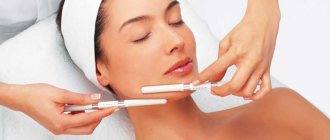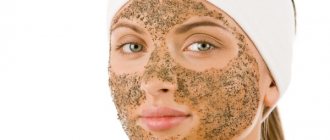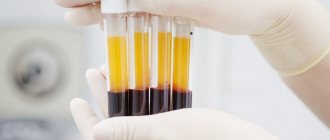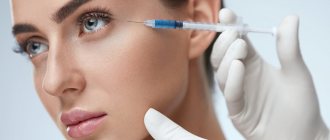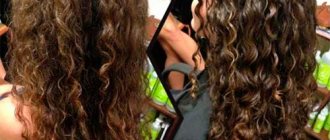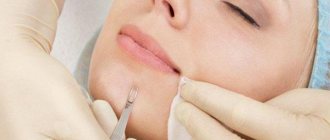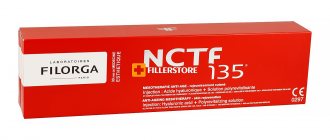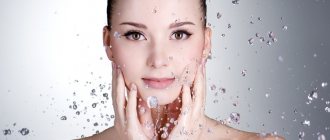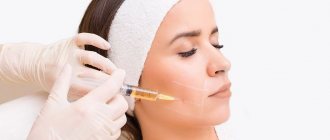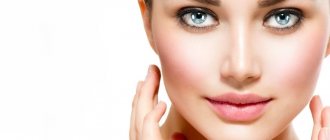Chemical peeling is a facial cleansing procedure by removing the top layers of skin, the epidermis. Chemical peeling allows you to solve many facial skin care issues in just one procedure - it is most effective and convenient for women of any age. Chemical peeling is done using various acids that penetrate the epidermis and remove surface skin particles. With the help of chemical peeling, you can get rid of wrinkles, excessive skin pigmentation, acne, potholes and pits of various origins in the shortest possible time - the effect will be immediate, but a certain recovery period will be required to evaluate the result.
For the chemical peeling procedure, phenol, glycolic, salicylic or trichloroacetic acid, as well as lactic and fruit acids are used - each substance is intended for its own type of cleaning. Chemical peeling is effective at any age, but it is recommended not to carry out the procedure too often - read more about this in the blocks on superficial, medium and deep facial cleansing.
What it is?
Our skin is constantly renewing itself, so exfoliating old cells is a natural process. But in real life, due to improper nutrition and care, stress, hormones and the environment, the process does not always proceed as it should. The skin flakes, becomes dull, clogged pores appear and much more serious consequences. Peeling removes that same old layer, giving freedom to renewed cells.
Precautionary measures
Facial peeling is a seasonal procedure. It is important that after the treatment the treatment site is not exposed to direct sunlight or frosty wind.
The reasons are:
- solar activity increases the risk of hyperpigmentation;
- wind can further injure the skin and slow down the recovery process;
- sudden changes in temperature (from cold to warm and vice versa) negatively affect the condition of blood vessels, as a result of which redness will last longer.
If you do not want or have the opportunity to wait for optimal weather conditions for peeling, a good option would be to carry out the procedure at home.
Types of peeling by depth of influence
This classification of the procedure takes into account how strongly and deeply the peeling affects the skin. While some types can be introduced into home care, others definitely require the participation of a certified specialist!
Superficial facial peeling
This is the softest and most delicate procedure with a slight exfoliating and smoothing effect. Usually it is done one time, and not in a course. It helps with fine wrinkles and blemishes and is also great at preventing rashes.
Medium facial peeling
In this case, the effect penetrates the entire thickness of the stratum corneum. In addition to smoothing wrinkles and lightening age spots, this procedure is suitable for getting rid of scars and scars.
Deep facial peeling
The most difficult procedure is done strictly as directed, because it is very aggressive. The skin is exposed to the entire thickness of the epidermis. It helps in combating dermatological problems and for rejuvenation. Most often, deep peeling is quite painful, but it triggers powerful regeneration processes.
Keratin hair straightening: pros and cons, post-procedure care
Reviews
Like any cosmetic procedure, chemical peeling can satisfy the needs of women in different ways - we suggest you familiarize yourself with the main types of reviews from patients of the clinic.
* * * * *
Alexandra
06.03.2018 12:20
The first time I carried out superficial cleaning on the advice of a friend, I was very afraid, so I consulted two dermatologists in advance about the safety of the procedure. It all passed quite quickly, I felt nothing. The effect far exceeded expectations: better than the strongest masks, and lasted longer. Now I do this cleaning about three times a year.
* * * * *
Elizabeth
22.02.2018 14:11
With age, wrinkles became very noticeable, so without much thought I decided to undergo a radical cleansing. Since I had never performed such procedures before, it was quite unpleasant even with anesthesia, but it all went away quite quickly. I spent my winter vacation completely at home, that’s 3 weeks. The clinic said that in the summer they don’t do deep peeling at all because it’s very dangerous. I was more than pleased with the result, but for a very long time I could not get rid of the unusual feeling of tightness that remained after the procedure - it went away on its own after a month and a half.
* * * * *
Angela
17.11.2017 17:36
I chose the middle cleaning, everything was done quickly and efficiently, I didn’t feel any pain. Compared to any creams and masks, peeling is much more effective, it’s impossible to even compare. I haven’t thought about repeating the procedure yet, everything suits me.
Techniques and methods
Peeling is also distinguished by the method of exposure. This means that different drugs and different equipment are used. All of them can be divided into four large categories.
Mechanical peeling
It can be cosmetic, using scrubs - and is used rather to cleanse and lightly exfoliate the skin. Or it can be hardware-based - using special brush attachments or a vacuum apparatus. In any case, the point is the abrasive effect. This is a superficial or mid-superficial procedure.
Chemical peeling
Acidic preparations cause a microburn to old cells, causing them to die and open a new layer. For the superficial treatment, soft fruit, lactic and glycolic acids are used. For medium - more concentrated salicylic or acetic acid, and for deep - phenols.
Ultrasonic peeling
This is a hardware procedure, but it has long been classified as a separate category. Roughly speaking, ultrasound knocks out all impurities from the skin, so that it cleanses and becomes softer. In fact, it is more of an ultrasonic cleaning.
Laser peeling
Depending on the settings, the laser beam penetrates to different depths and produces different effects. Superficial cold and hot laser peeling makes the skin velvety, smooth and elastic. Medium and deep grinding helps with scars, deep wrinkles and even when removing tattoos.
Contraindications
The procedure for chemical facial cleansing cannot be performed for the following diseases:
- dermatitis;
- neurodermatitis;
- psoriasis;
- cancer diseases;
- keloid and hypertrophic scars;
- fresh wounds, including open injuries;
- cuts and scratches on the skin;
- purulent inflammatory processes;
- pronounced allergic reactions;
- individual pathological reactions to chemical drugs.
In all these cases and many others, chemical peeling (especially deep) is contraindicated. Even in the absence of visible contraindications, it is necessary to consult a dermatologist before performing the procedure!
Flaws
For salon peeling to be as effective as possible, it must be done regularly. After the procedure, the skin requires special care and careful handling. It is not recommended to do chemical peeling in the summer when the sun is too active.
Only a specialist can choose the type of peeling and frequency of procedures to suit your skin. An incorrectly performed procedure or improper aftercare can lead to the appearance of age spots, rosacea, and redness.
How to do facial peeling at home: the best recipes
How to do it at home: stages of the procedure
You can do facial peeling yourself at home. The step-by-step procedure is divided into 4 stages:
- Preparatory. The skin should be thoroughly cleaned of makeup. To do this, you need to treat your face with a cotton pad soaked in a cleansing solution. Then apply a tonic that will restore water balance.
- Basic. The selected acid solution should be applied to well-cleansed skin. After some time, a tingling sensation will be felt. You shouldn’t be afraid of such sensations - this is how the composition begins to work.
- Neutralizing. After the required time has passed, you need to apply a neutralizing solution to the skin, which will help restore the protective barrier.
- Final. After the procedure, you must apply a moisturizer.
You can choose a peeling composition from pharmaceutical preparations:
- salicylic acid tablets;
- hydrogen peroxide 3%;
- camphor or boric alcohol;
- baking soda;
- sea salt;
- badyaga;
- fruit acid concentrate;
- minerals;
- calcium chloride solution no more than 5-10%.
How to care for your skin after peeling
The main rule after any peeling is to always apply sunscreen. Even in winter or if you only go outside for five minutes, otherwise this is a sure way to premature aging and age spots. You can also use antioxidant serums with vitamins C and E.
After chemical peeling, you should not use decorative cosmetics until the skin is completely restored. For care, use only those products that have been selected by a specialist. Avoid gyms and any workouts, baths, saunas, beaches for a week. You should absolutely not use anything abrasive, acidic or simply too aggressive.
Short haircuts for round faces: 10 fashionable ideas
What are the varieties?
All types of facial peels are distinguished by the method of exposure and the use of active ingredients.
Ultrasonic peeling
Ultrasonic facial peeling is a procedure during which an ultrasonic wave destroys the upper layer of the epithelium. The ultrasound wave penetrates deep into the skin and removes the contents of pores and sebaceous plugs to the outside. As a result of the procedure, blood flow accelerates, cell renewal is activated, and rejuvenation processes are launched.
This method is convenient because it has no seasonal or age restrictions and allows you to cope with a wide range of problems. As a result of a course of procedures, patients normalize their skin condition, improve the appearance and tone of the skin, and increase the protective properties of the skin.
We recommend: What is the difference between peeling and scrub and which is better?
Modern cosmetology allows you to carry out the ultrasonic cleaning procedure at home thanks to portable devices. We recommend taking a closer look at multifunctional devices; in particular, the ReadySkin ZX7080 occupies a high position in the current budget segment.
Users note the high efficiency of the device.
The main indications for use are:
- comedones, acne;
- unhealthy complexion;
- wide pores, bumpy skin surface;
- signs of aging and skin withering;
- blackheads, acne;
- dark spots;
- swelling, impaired lymphatic drainage functions.
Thanks to the advent of portable devices, modern cosmetology allows ultrasonic cleaning to be carried out at home. In the current budget segment, ReadySkin devices occupy high positions. In addition to ultrasonic peeling, the ReadySkin ZX7080 and ReadySkin ZY8300 devices combine a number of additional functions.
Both devices support disincrustation, phonophoresis, micromassage and lifting modes. New for 2021, the ReadySkin ZY8300 device has an additional thermal massage function and also allows you to operate at a frequency of 30 kHz from a power outlet, which has a positive effect on the result of the procedure.
Users note the high efficiency of the devices.
They help solve problems such as:
- Blackheads, acne;
- Comedones and acne;
- Wide pores, uneven skin surface;
- Regular use of the devices allows you to cope with fine wrinkles, increases skin elasticity, makes age spots less noticeable and improves complexion.
Surface chemical using acids
It is carried out using fruit and lactic acid. It is safe because it does not affect the deep layers of the epidermis. There is no pain during the procedure. Superficial peeling is done with complex correction, since during cleansing the active ingredients of cosmetic products penetrate into the skin.
In the first minutes after the procedure, peeling and redness appear on the skin. After a few days, the dermis begins to peel off in pieces, the pores narrow, and an inner glow of the skin appears.
Superficial facial peeling gives the following results:
- a healthy complexion appears;
- pigment spots are whitened;
- yellowness is removed;
- the relief is leveled;
- fine wrinkles are reduced;
- minor defects are eliminated.
Superficial peeling is primarily intended to treat dry skin problems.
Compositions with:
- vitamins;
- bleaches;
- biostimulants;
- humidifiers.
Median
This cleansing helps remove skin tissue down to the papillary layer. For the procedure the following are used:
- salicylic;
- retinoic;
- trichloroacetic acid.
Medium peeling has the following effects on the epidermis:
- improves complexion;
- increases turgor;
- pigmentation disappears;
- eliminates scars and post-acne.
This procedure should be carried out in the autumn-winter period, when the activation of the sun is minimal. Ultraviolet rays after a mid-peeling can cause the formation of age spots.
It is important to know! Medium peeling is strictly prohibited if there is inflammation on the skin. Otherwise, the rash will spread all over the face.
Deep using phenol
This procedure is characterized by maximum pain, since all layers of the epidermis are damaged. Deep peeling is done under general anesthesia in a hospital setting; there must be a resuscitation team on staff. Recovery after deep peeling takes about 1-3 months. The main substance used is phenol.
Immediately after the procedure, the face becomes covered with red-brown spots, crusts, and swells. Areas that have become keratinized after peeling should never be torn off. This can lead to scarring. During the first month, redness remains, then the skin on the face turns pink, and after a while it takes on a healthy appearance.
Effectiveness of deep peeling:
- pronounced facelift;
- reduction or complete elimination of wrinkles;
- healthy complexion;
- removal of pigment spots.
If you do not follow the cosmetologist’s recommendations during the rehabilitation period, the following side effects may occur:
- hyperpigmentation;
- the likelihood of inflammatory processes;
- allergic reactions;
- scarring of the skin.
We recommend: Peeling for rosacea. What type of procedure should I choose for sensitive skin?
Relative contraindications to deep cleaning sessions are:
- herpes on the face;
- renal failure;
- diseases of the cardiovascular and urinary systems.
Facial peeling - before and after photos
Did you like the post? Subscribe to our channel in Yandex.Zen, it really helps us in our development!
Preparation for the procedure
No special preparation is required for chemical peeling. It is advisable to come to the clinic without makeup, this will speed up and simplify the procedure. But if you come with make-up, the doctor will simply thoroughly cleanse your skin of cosmetics and impurities. It is advisable not to overexpose yourself to the sun before the session. The procedure is minimal, but it injures the upper layers of the skin, so it is better to take care of your face in advance.
MIGUNOVA ANASTASIA ANDREEVNA
Cosmetologist
Initial consultation: RUB 4,500
Make an appointment with a doctor Instagram
VYATKINA IRINA SERGEEVNA
Gynecologist-endocrinologist
Initial consultation: RUB 8,500
Make an appointment with a doctor Instagram
KALININA EKATERINA ALEXANDROVNA
Cosmetologist
Initial consultation: RUB 4,500
Make an appointment with a doctor Instagram
KOZLOVA EKATERINA NIKOLAEVNA
Gynecologist-endocrinologist, oncologist
Initial consultation: RUB 5,000
Make an appointment with a doctor Instagram
Which drug should I choose?
The choice of professional facial peeling products should be entrusted to a cosmetologist. The range of preparations for cleansing procedures is huge. Particularly popular are compositions based on the following components:
- lactic acid;
- glycogel acid;
- ascorbic, salicylic acid;
- fruit acids (malic, citric).
The excipients include brightening and moisturizing components, extracts of berries, fruits, green tea, enzymes, chitosan, and natural oils.
High-quality and effective facial peelings are produced by well-known cosmetic brands from Israel, Spain, France, and Germany. Russian products from the Natura Siberica company, which produces various types of glycolic and fruit peels, are also deservedly popular. The most important thing is to choose the right product that is ideal for your skin, will not cause irritation or adverse reactions, and will help effectively solve existing problems.
Separately, it is necessary to mention problem skin, because exfoliation is not only a cosmetic, but also a therapeutic procedure. It is used to eliminate acne, cleanse clogged pores, normalize the functions of the sebaceous glands, and prevent inflammatory processes. In this case, salicylic acid-based preparations are used during the procedure. It has a powerful keratolytic effect - exfoliates dead cells, dries, and provides an anti-inflammatory and antiseptic effect.
Impact zones
Peels are recommended for treating the following areas:
- Face – exfoliation is used to correct age-related changes and improve the appearance of the skin.
- Body – in combination with other procedures, body peeling helps get rid of cellulite, stretch marks, and improve the elasticity and firmness of the skin.
- Hair – the procedure is used to cleanse the scalp of dandruff, manifestations of seborrhea and dermatitis. In combination with massage and nourishing masks, it improves cell nutrition, blood circulation and metabolic processes, and stimulates hair growth.
The procedures must be performed by a professional cosmetologist who will correctly assess the condition, skin type, individual characteristics of the patient, and possible contraindications.
Deep peeling
The best facial peeling for ladies with mature skin allows you to cope with skin problems after 50 years. Having a deep peel in a salon means forgetting about problems for several years.
The deep type of procedure is carried out using substances such as phenol or a high concentration of trichloroacetic acid solution. However, phenol is a very toxic substance, even in some cases it can cause heart failure.
What happens to the skin during laser peeling
Laser peeling can be hot or cold. During the cold peeling procedure, the laser beam hits only the deep layers of the skin without damaging the epidermis. This way there is no open wound on the face and the risk of infection is eliminated.
During cold laser peeling, an area of traumatized skin is formed in the areas where the laser is pinpointed. There the recovery process begins immediately.
Read also: The best eyebrow pomades
